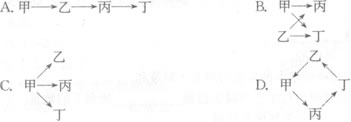2016 Adult College Entrance Examination Ecology Basic Simulation Test Questions and Answers (1)
(Examination time 150 minutes)
1、 2016 Adult College Entrance Examination Ecology Basic Simulated Test - Multiple Choice: This big question has 20 subtopics, 2 points for each subtopics, 40 points in total. Of the four options given in each subtopic, only one is consistent with the meaning of the question. Please put the letter before the choice in the parentheses after the question.
1. The life form of perennial herbs is ()
A. Aboveground budding plant
B. Epiphyte
C. Epiphyte
D. Cryptophyte
2. In the process of biological evolution, the climate that K countermeasures adapt to should be ()
A. Mild climate
B. Hot climate
C. Changeable climate
D. Stable climate
3. Experiments show that () is beneficial to protein synthesis
A. Red light
B. Qingguang
C. Purple light
D. Blue light
4. Ecotype is the same plant's ()
A. Divergent adaptation
B. Convergent adaptation
C. Identical reaction
D. No reaction
5. If an area is protected and other animals (usually the same kind of animals) are not allowed to enter, then this area is called ()
A. Field
B. Home domain
C. Geography
D. Boundaries
6. The constituent units of the community are ()
A. Individual
B. Various animals
C. Population
D. Various plants
7. The correct statement about the second law of thermodynamics is ()
A. The efficiency of the energy conversion process of any system is 100%.
B. High quality energy generated in any production process is equal to its input energy
C. The energy in the ecosystem always decays and dissipates in the process of transformation and flow
D. Also known as the law of conservation of energy
8. The mountain breeze is characterized by ()
A. The airflow on the hillside or mountain top flows into the valley, and the mountain wind is very dry
B. The airflow on the hillside or mountain top flows into the valley, and the mountain wind is not dry
C. The airflow in the valley rises along the slope, and the mountain wind is very dry
D. The airflow in the valley rises along the slope, and the mountain wind is not dry
9. When a single population grows exponentially in an unlimited environment, its growth rate is ()
A. Variable
B. Constant value
C. Negative value
D. Zero value
10. In the population growth model of non overlapping generations, in the equation, when λ>1, the change of population quantity is ()
A. Population decline
B. Stable population
C. Population increase
D. The population perishes without reproduction
11. The following non industrial auxiliary energy is ()
A. Animal strength
B. Fertilizer and pesticide
C. Agricultural machinery
D. Agricultural plastics
12. The intrinsic natural growth rate refers to the stable maximum () determined by the internal factors of the population when the environmental conditions have no restrictive effects
A. Absolute multiplication rate
B. Relative multiplication speed
C. Balance proliferation speed
D. Uniform multiplication speed
13. In the warm temperate zone of China, the pH value of the soil with the best nutrient availability and most favorable for plant growth is ()
A.oH5~6
B.pH6~7
C.pH7~8
D.pH8~9
14. Biological adaptation to high temperature is characterized by ()
A. Reduce cell water content and increase soluble sugar
B. Reduce cell water content and soluble sugar
C. Increase cell water content and soluble sugar
D. Increase cell water content and reduce soluble sugar
15. One of the following incorrect descriptions of allelopathy is ()
A. Allelopathy has the phenomenon of resting
B. Although one plant has influence on other plants, it does not secrete chemicals in the metabolic process
C. Allelopathy causes the appearance of one kind of plant to cause the extinction of another kind of plant
D. Allelopathy causes the selectivity of plant species to the community
16. Which nutritional structure of the following four biological ecosystems is the most stable ()

17. The efficiency of plants using solar energy is only a few thousandths, or even ten thousandths, and the average crop is only ()
A.5%~10%
B.1%~2%
C.10%~20%
D.0.1%~0.2%
18. The following which do not belong to the type of population age structure are ()
A. Growth
B. Random
C. Stable
D. Decline type
19. After abandoned farmland in Inner Mongolia grassland, the last community restored is ()
A. Mixed leather community
B. Artemisia annua community
C. Grass community
D. Stipa baikalensis community
20. The following characteristics of aquatic plants are correct ()
① Developed ventilation system
② Very thick blade
③ Plants have strong elasticity
④ Freshwater plants have the ability to automatically regulate osmotic pressure
A.①②③
B.②③④
C.①③④
D. All correct
2、 2016 Adult College Entrance Examination Ecology Basic Simulation Test - Fill in the blank: this big question has 20 small questions. There are 20 blanks in total, 2 points for each blank. A total of 40 points. Fill in the answers on the line.
21. Terrain affects organisms by changing other ecological factors, so terrain is called ______ ecological factor.
22. The main characteristics of the animal field are exclusiveness, ______ and substitutability.
23. The ______ of the internal environmental factors of the community is the main reason for the mosaic of the community.
24. In the plant population, in the high-density quadrats, some plants died, so the population began to appear ______.
25. The main reason why the growth efficiency of thermostatic animals is lower than that of variable temperature animals is ______.
26. Population growth includes positive growth, negative growth and ______.
27. Soil organic matter includes non humus and ______.
28. Due to the influence of monsoon climate, the wind in winter in China is mostly ______.
29. Genes and ______ are the basis of ecosystem diversity.
30. The population density can be divided into coarse density (or original density) and ecological density. The density calculated according to the space actually occupied by organisms is called ______.
31. Ecology can be divided into ______ and water ecology according to biological habitat (also called habitat type).
32. The plant that plays a major role in the formation of community structure and community environment is ______, which has a controlling influence on the whole community.
33. Among vertebrates, the photoperiod of ______ is the most obvious.
34. Ecological factors close to or exceed the tolerance limit of certain organisms and prevent their survival. When growing, reproducing, diffusing or distributing, these factors are called ______.
35. Environment can be divided into natural environment, ______ and social environment according to its nature.
36. Ecological agriculture is different from traditional agriculture. Its main characteristics are: integrity, hierarchy, regionality, regulation and ______.
37. Biodiversity mainly includes genetic diversity, ______ and species diversity.
38. Succession can be divided into ______ and secondary succession according to the nature of matrix.
39. The countermeasure for living creatures to survive in the struggle for survival is called ______.
40. According to the scope of the environment, the environment can be divided into cosmic environment, ______, regional environment, micro environment and internal environment.
3、 2016 Adult College Entrance Examination Ecology Basic Simulation Test - Judgment: This big question has 10 subtopics, each subtopics has 2 points, and a total of 20 points.
41. Modern ecology focuses on human research and pays more attention to practical research. ( )
42. Short day plants can obtain a longer vegetative growth period in the north. ( )
43. The population growth rate is determined by the birth rate and death rate. ( )
44. Most mammals belong to K-countermeasure organisms. ( )
45. The result of interaction between predator and prey is coevolution. ( )
46. Biological community is a group composed of many animals and plants. ( )
47. The more distant plants are, the less likely they are to have the same life form. ( )
48. After the destruction of the original forest, the process of forest formation is primary succession. ( )
49. Due to extreme drought, only xerophytes survive in the desert. ( )
50. The disturbance of human activities is not conducive to the balance of the ecosystem. ( )
4、 2016 Adult College Entrance Examination Ecology Basic Simulation Test - Short answer question: there are 3 sub questions in this big question, 10 points for each sub question, 30 points in total.
51. Briefly describe the meaning and basic types of population age structure.
52. Briefly describe the concept of biodiversity and its three levels.
53. Briefly describe the relationship between temperature and biological distribution.
5、 2016 Adult College Entrance Examination Ecology Basic Simulation Test - Discussion: 54 questions, 20 points.
54. Discuss new strategies for energy development.
Reference answers to 2016 adult college entrance examination ecology basic simulation questions:
1、 2016 Adult College Entrance Examination Ecology Basic Simulated Test - Multiple choice answer
1.B2.D3.D4.A5.A6.C7.C8.A9.B10.C
11.A12.B13.B14.A15.B16.B17.B18.B19.D20.C
2、 2016 Adult College Entrance Examination Ecology Basic Simulation Test - Answer to the blank
21. Indirect
22. Scalability
23. Non uniformity
24. Self thinning phenomenon
25. Breathing consumes more energy
26. Zero growth
27. Humus
28. North
29. Species diversity
30. Ecological density
31. Terrestrial Ecology
32. Dominant species
33. Birds
34. Limiting factors
35. Semi natural environment
36. Constructive
37. Ecosystem diversity
38. Primary succession
39. Ecological Countermeasures
40. Earth environment
3、 2016 Adult College Entrance Examination Ecology Basic Simulated Test - Judgment Answer
41.√42.√48.×44.√45.√ 46.×47.×48.×49.×50.×
4、 2016 Adult College Entrance Examination Ecology Basic Simulation Test Questions - Answers to Short Answers
51. (1) The proportion of individuals of all ages in the population is age structure.
(2) The basic types of age structure are as follows:
① Growth. The age cone is a typical pyramid with a wide bottom and narrow top (or answer: there are more young people than old people), and the population is in the growth period.
② Stable. The age cone is roughly bell shaped, the proportion of individuals at each age level is moderate, and the population number is stable.
③ Declining type. The age cone is narrow at the bottom and wide at the top (or answer: fewer young individuals and more elderly individuals), and the population is in a declining state.
52. Biodiversity refers to the diversity and variability of organisms and the ecological complexity of habitats.
(1) Genetic diversity: refers to the diversity of genetic information contained in each species.
(2) Species diversity: refers to the diversity of biological species on the earth.
(3) Ecological (or ecosystem) diversity: refers to the diversity of biological communities, habitats and ecological processes in the biosphere.
53. (1) When the ambient temperature is higher or lower than the maximum or minimum critical temperature of organisms, life activities are restricted or unable to survive. Therefore, organisms are often distributed near their optimum temperature.
(2) Since the optimum temperature of most organisms is 20~30 ℃, there are many species of organisms distributed in warm areas and few species in cold areas.
(3) The factor determining the biological distribution is not only the temperature factor, but also the most important factor affecting the biological distribution. Temperature and precipitation together determine the general pattern of biological community distribution.
5、 2016 Adult College Entrance Examination Ecology Basic Simulated Test Questions - Argument Questions Answers
54. (1) At present, there are three main ways to develop new energy strategies: first, attach great importance to the development and utilization of new energy; Second, attach importance to energy conservation and improve energy utilization efficiency; The third is to adjust the energy structure, that is, to improve the quality of energy.
(2) There are two basic ways to improve China's energy quality structure: first, substantially increase the proportion of coal used for power generation and increase the proportion of terminal power consumption. Another aspect of coal conversion is the development of gas, liquefied fuels and coal chemical industry. The second is to strengthen the development of high-quality primary energy other than coal, including nuclear energy, hydropower, other renewable energy and oil and natural gas.
(3) The main fields of new energy include solar energy, wind energy, ocean energy, biomass energy, geothermal energy and hydrogen energy.

























